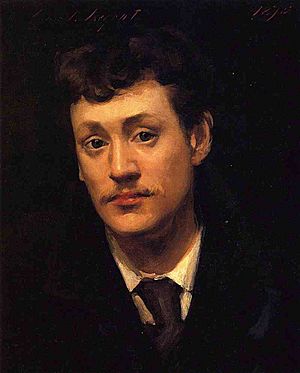Frank O'Meara facts for kids
Quick facts for kids
Frank O'Meara
|
|
|---|---|

Frank O'Meara, John Singer Sargent, 1876
|
|
| Born |
Francis Joseph O'Meara
30 March 1853 Carlow, Ireland
|
| Died | 15 October 1888 (aged 35) Carlow
|
| Resting place | Bennekerry, Carlow |
| Nationality | Irish |
| Known for | Impressionist painting |
| Movement | Impressionism |
Francis Joseph O'Meara (born March 30, 1853 – died October 15, 1888) was an Irish artist. He was famous for his landscape paintings in the Impressionist style.
Contents
Frank O'Meara: An Irish Artist
Early Life and Family
Frank O'Meara was born in Carlow, Ireland, on March 30, 1853. His parents were Thomas and Sarah O'Meara. He was the youngest of seven children. His father was a doctor. His grandfather, Dr Barry Edward O'Meara, was even Napoleon's doctor!
The O'Meara family lived in Carlow. Frank probably went to St. Mary's Knockbeg College for school. From 1869 to 1871, he lived in Dublin. During this time, he might have continued his studies or taken private art lessons. An early sketchbook shows that he drew landscapes from around County Carlow. He also drew churches and animals.
Sadly, two of Frank's siblings died young. His mother passed away in 1873. After this, he moved to Paris, France. His cousin, Kathleen O'Meara, was a writer there.
Becoming an Artist
In Paris, Frank O'Meara became one of the first students of a famous artist named Carolus Duran. He studied alongside other students from England, France, and America. One of his fellow students was John Singer Sargent, who later became very famous.
While studying, Frank's friends noticed he was a bit quiet and thoughtful. Some people think this was because he lost his siblings and mother when he was young. This thoughtful nature often showed up in his paintings.
Life in Grez-sur-Loing
In 1875, Frank visited artist communities. He first went to Barbizon, then settled in Grez-sur-Loing. He became good friends with the writer Robert Louis Stevenson there. Frank stayed in Grez-sur-Loing for almost 11 years. He would only leave for short times in winter or for art shows.
He loved to paint en plein air, which means painting outdoors. He especially liked painting in the soft, grey light of the evening. In 1876, Fanny Osbourne and her daughter Isobel came to Grez. They became friends with Frank. They would visit art galleries in Paris and paint together.
When the Osbournes went back to California in 1878, Frank gave Isobel a portrait of himself. This portrait was painted by John Singer Sargent. Many of Frank's friends left Grez, but he stayed. He kept painting and living at the Hôtel Chevillon.
What His Art Looks Like
Frank O'Meara's paintings often have a few special things you can spot. He often painted lonely women, usually near water. There are often bare trees in autumn, shown in the evening light. His work can feel a bit sad or thoughtful. Some say this feeling came from his own life challenges and health issues.
Frank was a popular friend among English-speaking painters. This included artists like John Lavery, William Stott, and Carl Larsson. William Stott's art shows the most influence from Frank. John Lavery even said that Frank influenced him the most out of all the artists in Grez.
Frank was a slow painter. He usually only finished about three pictures a year. His work was shown in a few exhibitions. These included shows in London, Liverpool, and Glasgow.
His Legacy
Frank O'Meara returned to Carlow in the spring of 1888. He sadly died on October 15 of that year, when he was only thirty-five. He had been sick for several years. Many people believe he could have become an even greater artist if he had lived longer.
His work was included in several art shows after his death. These included "The Irish Impressionists" at the National Gallery of Ireland in 1984. Today, five of his paintings are at the Hugh Lane Gallery of Modern Art in Dublin. Another painting can be seen at the Ulster Museum in Belfast.
Frank O'Meara's art was "rediscovered" in the late 1990s. This means people started to notice and appreciate his work much more. His paintings began selling for very high prices at auctions. For example, in 1999, his painting Reverie sold for hundreds of thousands of pounds!
Images for kids



